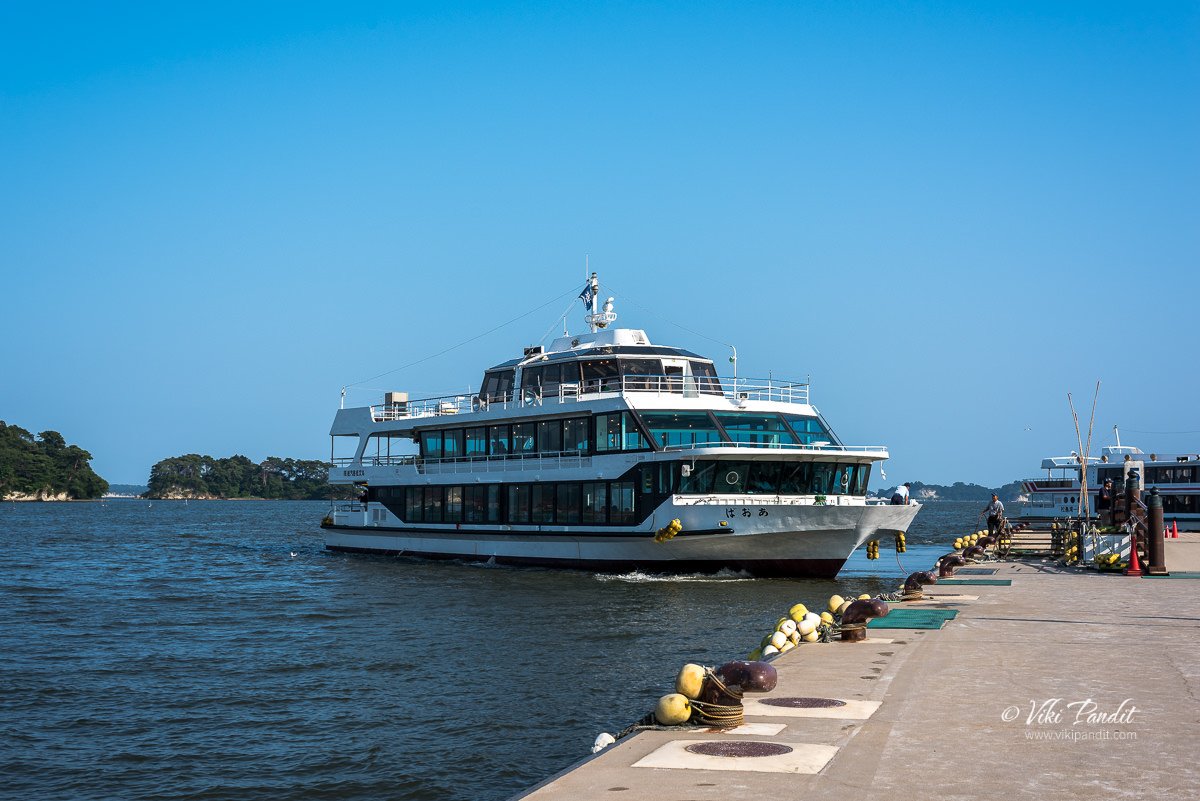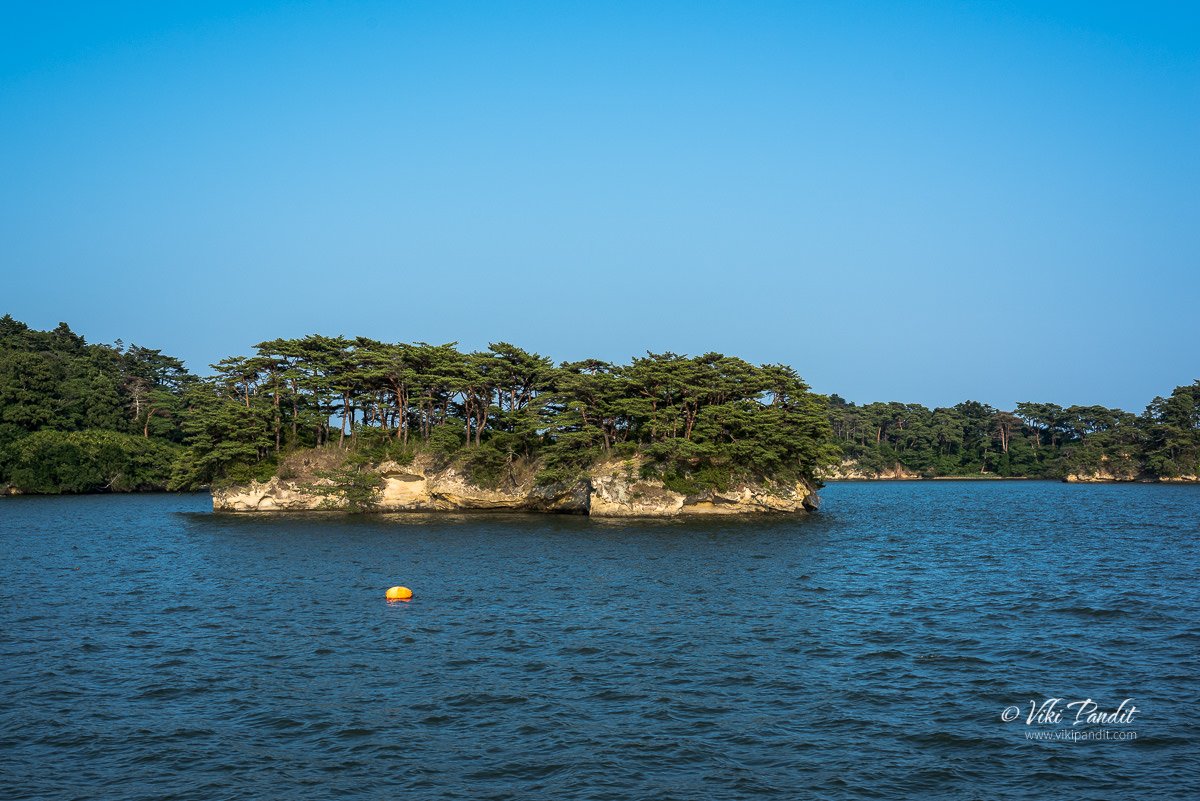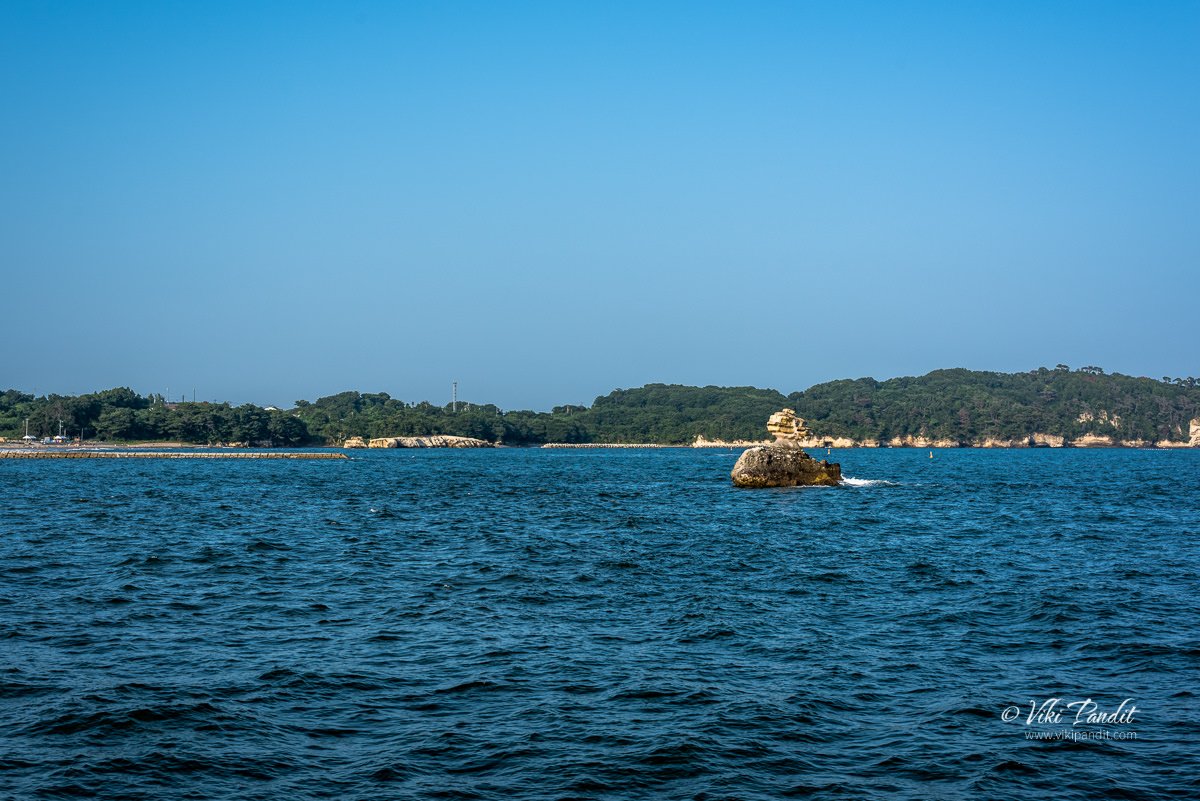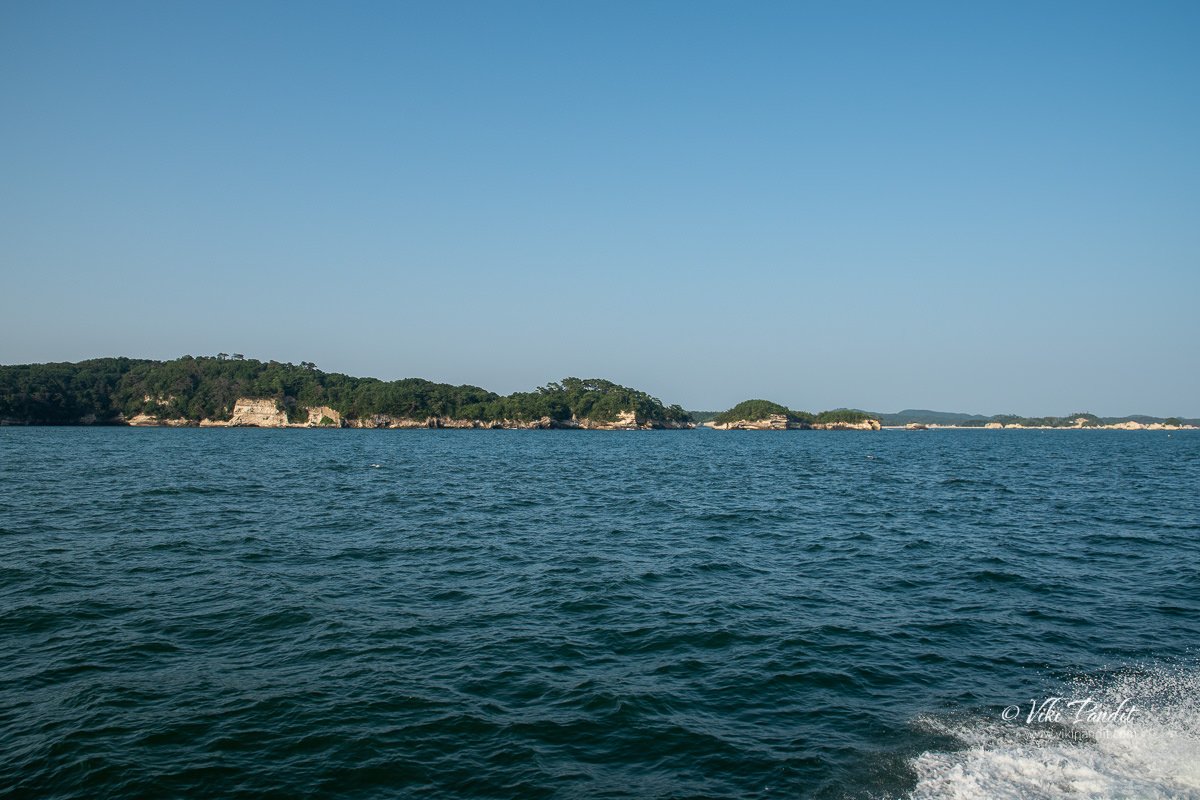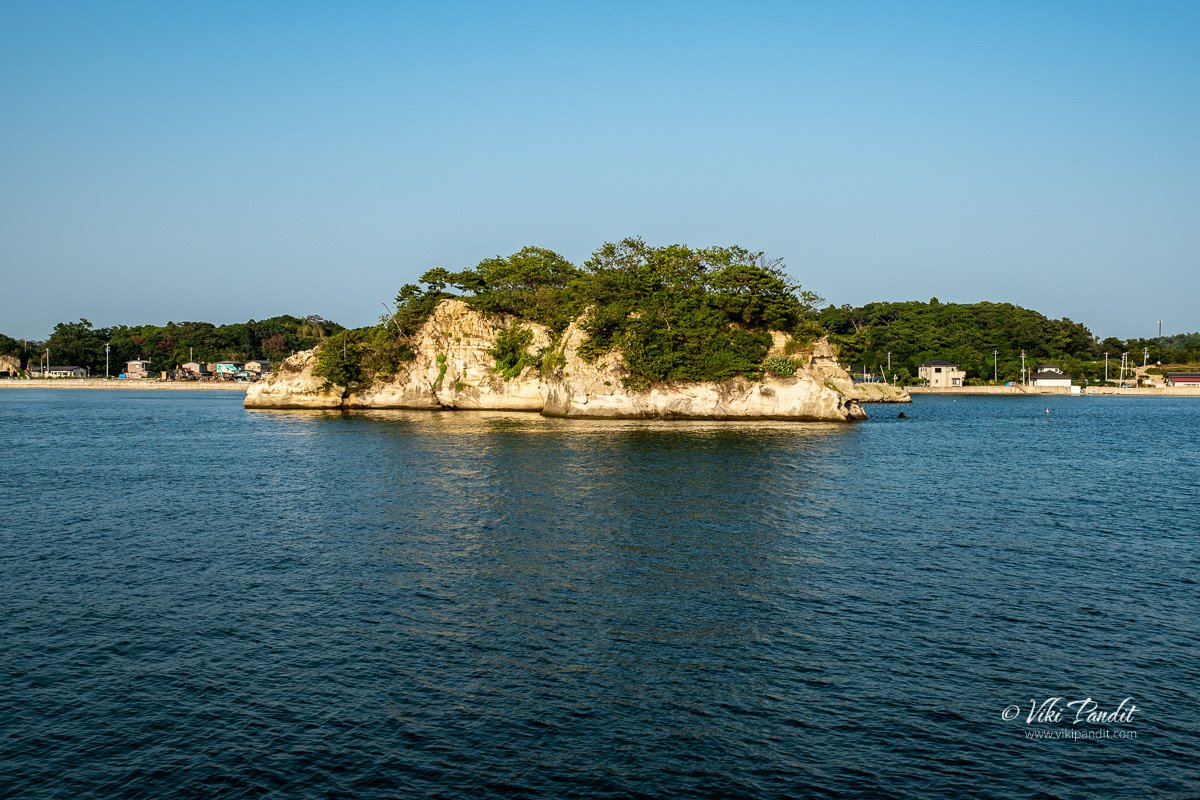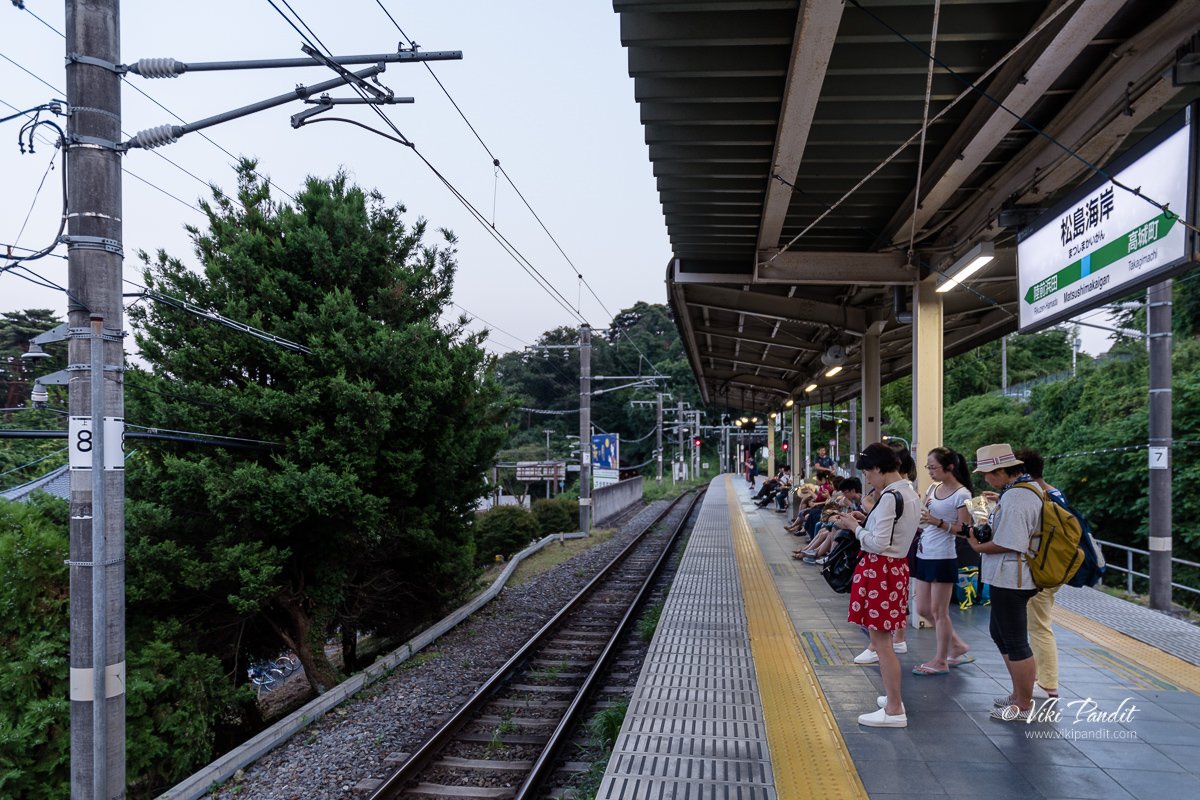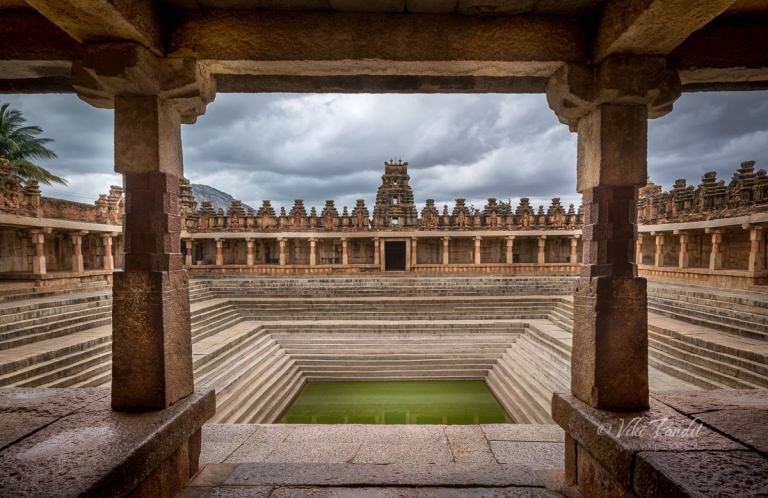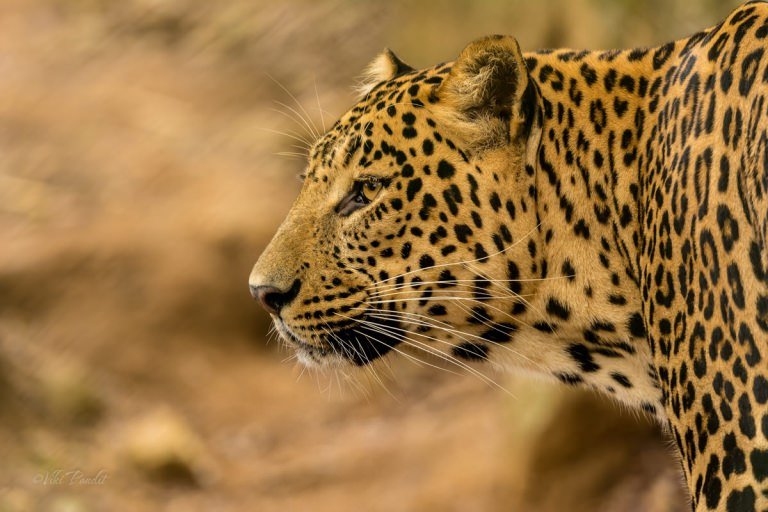Designated as one of the Nihon Sankei – the three most scenic views in Japan, alongside Miyajima & Amanohashidate, Matshushima is dotted by as many as 260 islands scattered throughout the picturesque Bay. Today we take a cruise through these pine-covered islands that have left poets smitten across the ages.
We were in Sendai. We spent the early part of the day roaming the streets among the Tanabata celebrating crowds. After an early lunch we rode the local Ishinomaki local from JR Sendai Station to Matsushima-Kaigan Station. Matsushima Bay area is at a walk-able distance from here.
Matsushima Bay Cruise
After reaching Matsushima Bay, we walked straight to the admission counter for the cruise rides. Cruises depart from the boat pier next to the admission booth. The view from Matsushima Pier is itself lovely, but we wanted to get on the boat cruise to see the beautiful islands at close quarters.
There are two options for the cruise, you can either choose the round-trip cruise that comes back to the starting point or get down at Shiogama Pier midway. We choose to go for the round trip ticket, which cost us ¥1500 per person.
We were scheduled for the 4 pm cruise. We had some time on our hands before our turn came along, so we took a short walk around the area. Along the bay, the first thing that catches your eye is the long red Fukuurabashi bridge.
Some boats were leaving with tourists as we wandered along the edge of the shore. It was a hot day combined with a lot of surrounding haze over the bay. On the eastern side you could still see lovely blue skies but the western skies were quite bland and white with the Sun trying to pierce through the haze.
Godai-do
Just a few paces ahead lay a small island connected by a red bridge. On the island, overlooking Matsushima Bay, you can find the Godai-do, a must-see symbol of Matsushima.
Originally known as Bishamon-do, it was founded in 807 CE, during the early Heian period by the shogun Sakanoue no Tamuramaro. However it shot to fame only after 828 CE when the revered priest Ennin, installed images of the Five Deva Kings within the Bishamon-do. From that time it came to be known as Godai-do, named after the five Buddhas of wisdom, housed within, and displayed to the public during a special ceremony only once every 33 years. It was last opened in 2006, so we have to wait another 23 years to view the statues.
The bridge has spaces between the planks. It is said that if you trip between these planks, you are not yet ready to reach the temple.
The Matsushima bay area has seen many natural disasters. The original building was destroyed in one of these unfortunate incidents. The building we see today was reconstructed by Date Masamune in 1604 CE.
This temple is the oldest Momoyama-style architecture in the Tohoku region and has been designated as an important cultural asset. The ceiling within this hall is said to be decorated with the twelve animals of the Chinese zodiac.
Surrounding the Godai-do, numerous pine trees hang out towards the outer edge of the island. The name of the bay Matsushima – matsu means pine and shima means island, is a clear giveaway why it was named so.
Once it was time for our cruise we made our way back to the pier.
The cruise boat was just arriving as we reached the dock. There are eight cruises per day (seven during the winter months) from 9:00 am to 4:00 pm, sailing every day of the year, weather permitting. The Niōmaru has capacity for 300 passengers, while the newer Niōmaru III can carry 400 people at a time.
Once everyone was off, we queued up to board the cruise boat. The boat has two decks and passengers can sit anywhere, the seats don’t have any numbering. We placed our bags on a couple of seats and walked out to the open area at the back of the boat, so we could enjoy a unhindered view of the beautiful archipelago. You can also go up to the more luxurious upper deck by paying extra ¥500.
As the boat left the shore, the sea gulls followed us into the ocean. One can buy food for the seagulls on the boat to feed them.
As the cruise starts, the first island that you see is obviously the lovely Fukuurajima Island on the left. The largest island in the bay functions as a natural garden. The bridge itself is called Fukuurabashi and is open to the public who can walk to the island by paying a small admission fee.
The Niōmaru boat cruise trip is of about 50 minutes and during that time you can enjoy the beautiful scenery of the islands, up close, with the blue sea as well as enjoy the fresh air around the bay.
Each of the island along the route has different shape and they all have different names and meanings. During the trip there was a running commentary for the entirety of the trip, which functioned as a guide as we passed certain important islands.
All explanations on my cruise were given in Japanese and I wasn’t able to figure out much other than the names of some of the islets. Not to forget, we kept running from side to side of the boat, trying to capture all the little islands that kept passing us.
Sightseeing boat announcements are available in both Japanese and English but they are at different times. Make sure you are buying tickets with the correct broadcast language.
These twin islets below are known as Futagojima.
The islands of Matsushima are the result of a geological phenomenon and each of the islets are points where an ancient valley covered by the water has emerged above the sea level caused by tectonic movements. The depth of the sea surrounding the archipelago does not exceed 10 meters at any point.
Over time, erosion has given these islands unusual forms, some of which looked like mushrooms. The favorable natural conditions caused pine trees to cover the archipelago with a mantle of greenery, making it a unique landscape in Japan.
Formation of Matsushima Bay
Matsushima Bay has been traditionally considered as a typical submerged coast, but research suggests that these islets were formed by a coastal mega-landslide in middle Holocene age, around 4000 BC.
A strong earthquake from nearby active fault was the most probable trigger of the landslide. Hills which used to be located around the area of Matsushima Bay, slid southeast parallel to the bedrocks without breaking into small fragments. The sliding surface, almost horizontal with its own topography formed a layer over the bay, resulting in creation of these small land masses all over the area.
The mega-landslide must have entered the sea and generated a maga-tsunami causing major loss of life to the surrounding Jomon population. Evidence from the shell mounds indicate that the early Jomon people in the area had started settling down on inconvenient highlands which were considered safer from landslides and tsunamis.
Unfortunately the tsunamis are still a cause pain today in nearby areas. One of my friends on Instagram, who is currently residing in Tokyo, had told me how many of his relatives and friends were killed in the disasters, while his home in Minamisanriku, Miyagi Prefecture, which had stood for 300 years and spanned 11 generations, was swept away by the tsunami. That’s a deep scar to live with. My prayers are with him and all the innocent souls lost to the tsunami on that unfortunate day.
After a few minutes we were far out in the ocean where you can unravel as to how far the archipelago stretches into the ocean. We passed by one of the most unique looking islands. Named Kanejima or the “Bell Island” it houses four arches of different sizes that go right through it.
Next on our radar was the Niojima. This is one of the most iconic island in the bay. People have given some strangest of descriptions of this island. Let me add another as to me it appeared as a whale blowing its snot.
We stopped at this point for a few minutes to allow the people on board to enjoy the lovely views of the ocean, after-which the boat turned back on-route to the shore. Longer cruises will get you to further remote areas of Oku-Matsushima.
Summit level of these Matsushima Islands are usually about 50 m high.
Matsuo Basho, one of the most famous of Japanese haiku poet, is said to have been at a loss for words when he first saw the hundreds of pine-clad islets scattered around Matsushima Bay during a 17th-century journey to the Tohoku region.
Heavily romanticized by Japanese travelers, the pine-covered islands, battered by wind and sea form a kind of Zen rock garden in the ocean.
We were back at the pier at around 5 pm. There was still daylight, and we didn’t want to back so soon.
After disembarking from our boat we turned right and walked along the main street which was lined with many interesting looking shops. We walked past the Godai-do, where we had already been earlier in the day and followed a narrow path along the ocean arriving at a tiny building at the mouth of the Fukuura Bridge.
Fukuura Island is one of the few pine covered islands in Matsushima Bay that is accessible to the public. The island is reached via this 252 meter long, red painted bridge.
The building serves to control access to the island and is where you pay the ¥ 200 admission to enter the island. It was 5 pm already and there was no one at the admission booth. We decided against going to the island as it would be dusk soon.
From what I read, there is not much to see on the island besides plants and views of the bay. The island is a natural botanical garden with a network of pleasant walking trails. It takes about one hour to walk all the trails at a leisurely pace. Some nice views of the bay can surely be enjoyed along the way.
We sat on a bench nearby, admiring the scene till the sunset. Once the Sun was gone we made our way back to Matsushima Kaigan Station for the train to Sendai. The train was still some minutes away so we waited at the platform with other visitors.
From Sendai we caught the Tohoku-Hokkaido Shinkansen to Morioka which was our next stop on our tour of the Tohoku region. It takes about 2 hours to reach Morioka from Sendai. It was pretty late into the night as we pulled into Morioka. The station though, was still alive with Tanabata decorations.
We grabbed some dinner from a convenience store nearby and headed to our hotel. The body seeps well after a tiring day, next day was going to be a long day as well as we were planning to go to Jodogahama Beach.
I didn’t have time to cover more of Matsushima. There are many other attractions in the Matsushima Bay area. Some of the popular temples include
- Zuiganji (the most renowned Zen temple in Tohoku area)
- Entsuin Temple (mausoleum of Date Mitsumune) and
- Tenrinin Temple (mausoleum of his daughter, Lady Iroha).
Fukuurajima (one of the islands covered by pines), is also worth a visit but unfortunately I was out of time. The long, red Fukuurabashi Bridge and Godaido Temple are also illuminated at night if you are interested.
Photographs can never tell the emotions I felt standing on the boat as I sped past these incredible shaped islands. I hope they can inspire some of you to reach out and witness what I have. If you visit Miyagi Prefecture and want to enjoy some fresh air as well as a mesmerizing scenery, then Matsushima Bay is definitely worth a visit!
Thanks for reading. I look forward to your comments and questions. If you are looking to explore more of the Tohoku region, follow my travels as I visit the Jodogahama Beach in the interiors of Morioka.
9 am to 4 pm
¥1500
¥ 2500 (between April and October only)
Disclaimer: The information presented in this article is based on the time I visited the premises. Note that there might be changes in the prices of merchandise and admission fees that might have occurred after this article was published. At times the facility might also be closed for repairs or for variety of other reasons. Kindly contact the facility or facilities mentioned in this article directly before visiting.
Usage of this site indicates acceptance of my Terms and Conditions.
Credits: The historical information presented herein is gathered mostly from local guides that were re-inforced via historical writings.






